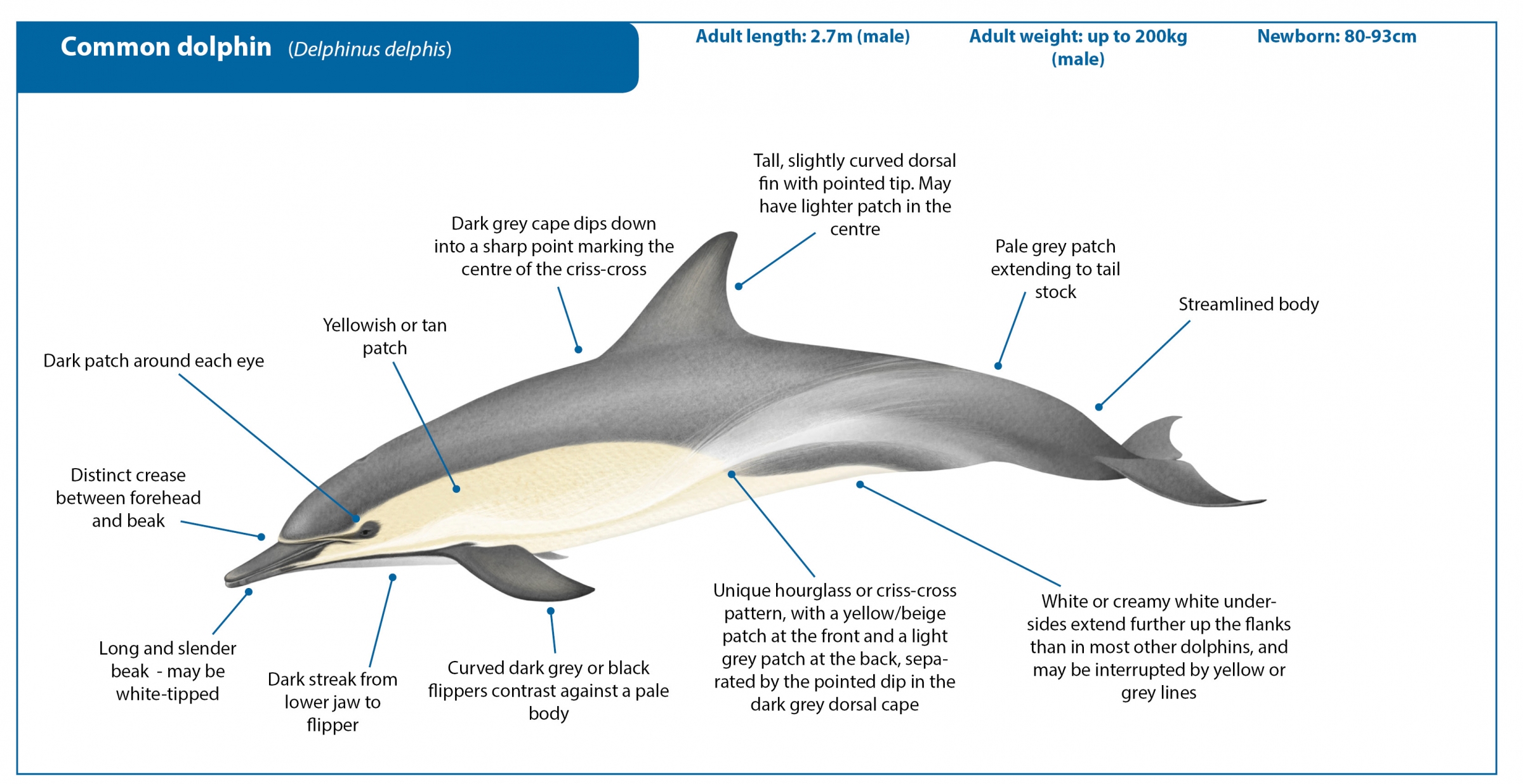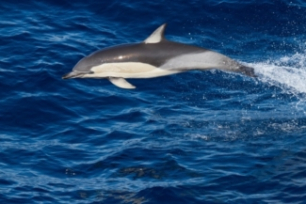Common dolphins are, as the name suggests, widely distributed throughout tropical and temperate waters, and can be found in both nearshore and offshore environments. They are easily recognizable by their striking hourglass or criss-cross pattern that includes a yellowish or tan patch, when almost all other dolphins are limited to shades of black, white and grey. For a time common dolphins were divided into two species – short-beaked common dolphins (Delphinus delphis) and long-beaked common dolphins (D. capensis). However, in 2015 genetic studies determined that all populations examined to date would be more logically grouped under one species (D. delphis) with four recognized subspecies of common dolphins throughout the species’ range: The common dolphin (D. d. delphis); Eastern North Pacific long-beaked common dolphin (D. d. bairdii ); the Black Sea common dolphin ( D. d. ponticus ); and the Indo-Pacific common dolphin ( D. d. tropicalis).1,2 Common dolphins can occur in nearshore or offshore environments, and while they are regularly seen in some areas, in others they are observed only as an added bonus to whale or dolphin watching tours that are focused on more predictable species.

References
Show / Hide References
- Committee on Taxonomy. List of marine mammal species and subspecies. Society for Marine Mammalogy, www.marinemammalscience.org, consulted on 11 October 2017. (2017).
- Cunha, H. A. et al. Molecular and Morphological Differentiation of Common Dolphins (Delphinus sp.) in the Southwestern Atlantic: Testing the Two Species Hypothesis in Sympatry. PLOS ONE 10, e0140251, doi:10.1371/journal.pone.0140251 (2015).
- Jefferson, T. A., Webber, M. A. & Pitman, R. L. Marine Mammals of the World: a Comprehensive Guide to their Identification. Second Edition. (San Diego: Academic Press, 2015).
- Perrin, W. in Encyclopedia of Marine Mammals Vol. Third Edition (eds B Würsig, J.G.M. Thewissen, & K.M. Kovacs) 205-209 (Academic Press, Elsevier, 2017 ).
- Ballance, L. T., Pitman, R. L. & Fiedler, P. C. Oceanographic influences on seabirds and cetaceans in the eastern tropical Pacific: A review. Progress in Oceanography 69, 360-390 (2006).
- Meynier, L., Stockin, K. A., Bando, M. K. H. & Duignan, P. J. Stomach contents of common dolphin (Delphinus sp.) from New Zealand waters. New Zealand Journal of Marine and Freshwater Research 42, 257-268 (2008).
- Spitz, J., Mourocq, E., Leaute, J., Quéro, J. & Ridoux, V. Prey selection by the common dolphin: Fulfilling high energy requirements with high quality food. Journal of experimental marine biology and ecology 390, 73–77 (2010).
- Young, D. D. & Cockcroft, V. G. Stomach contents of stranded Common Dolphins Delphinus delphis from the south-east of Southern Africa. International Journal of Mammalian Biology 60, 343-351 (1995).
- Querouil, S. et al. Why do dolphins form mixed-species associations in the Azores? Ethology 114, 1183–1194 (2008).
- Anderson, R. C. Cetaceans and tuna fisheries in the Western and Central Indian Ocean. International Pole and Line Federation Technical Report 2, 133 (2014).
- Fernandez-Contreras, M., Cardona, L., Lockyer, C. & Aguilar, A. Incidental bycatch of short-beaked common dolphins (Delphinus delphis) by pairtrawlers off northwestern Spain. ICES Journal of Marine Science 67, 1732–1738 (2010).
- Hamer, D. J., Ward, T. M. & McGarvey, R. Measurement, management and mitigation of operational interactions between the South Australian sardine fishery and short-beaked common dolphins (Delphinus delphis). Biological Conservation 141, 2865-2878 (2008).
- Kuiken, T. et al. Mass mortality of common dolphins (Delphinus delphis) in south west England due to incidental capture in fishing gear. Veterinary Record 134, 81-89 (1994).
- Mannocci, L. et al. Assessing the Impact of Bycatch on Dolphin Populations: The Case of the Common Dolphin in the Eastern North Atlantic. PLoS ONE 7, e32615, doi:10.1371/journal.pone.0032615 (2012).
- Bearzi, G. Delphinus delphis Mediterraenan subpopulation in The IUCN Red List of Threatened Species (http://www.iucnredlist.org/det... Consulted October 2017, 2003).
- Bearzi, G. et al. Overfishing and the disappearance of short-beaked common dolphins from western Greece. Endangered Species Research 5, 1 - 12 (2008).
- Birkun Jr, A. Delphinus delphis spp. ponticus in The IUCN Red List of Threatened Species (http://www.iucnredlist.org/det... Consulted October 2017, 2008).
- Bearzi, G. et al. Ecology, status and conservation of short-beaked common dolphins Delphinus delphis in the Mediterranean Sea. Mammal Review 33, 224-252, doi:10.1046/j.1365-2907.2003.00032.x (2003).
- Hammond, P. S. et al. Delphinus delphis in The IUCN Red List of Threatened Species (http://www.iucnredlist.org/det... Consulted October 2017, 2008).
- Hammond, P. S. et al. Delphinus capensis in The IUCN Red List of Threatened Species (http://www.iucnredlist.org/det... Consulted October 2017, 2008).
- Ponnampalam, L. S. Dolphin Watching in Muscat, Sultanate of Oman: Tourist Perceptions and Actual Current Practice. Tourism in Marine Environments 7, 81-93, doi:10.3727/154427311X13038402065866 (2011).
- Meissner, A. M. et al. Behavioural effects of tourism onoceanic common dolphins, Delphinus sp., in New Zealand: The effects of markov analysis variations and current tour operator compliance with regulations. PLOS ONE 10, e0116962, doi:10.1371/journal.pone.0116962 (2015).



